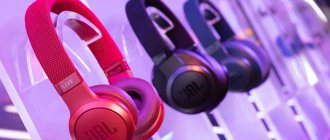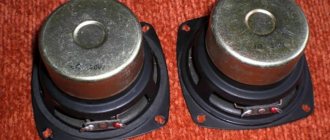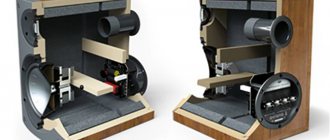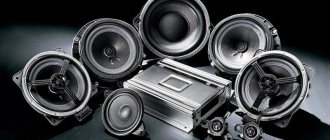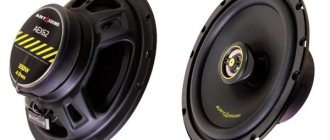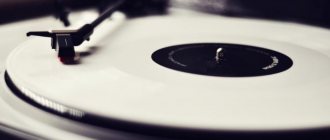Tube amplifiers. The sound of vacuum tubes
Dear TV viewers. Here is a brief look at some of the types of vacuum tubes suitable for use in tube audio. The presentation was made to clarify the concept of “sound quality” of an electron tube, which is clouded and muddied by amateurs. By the quality of sound created by the lamp mode in an electronic circuit, I understand and will understand the minimum possible level of distortion of the electrical signal. Harmonic and intermodulation distortions should be considered the most significant. The text of the article is given below with an assessment of the psychophysiological characteristics of human perception of sounds, so first a lyrical introduction.
An electronic tube in ULF is, in a general sense, an analogue of an engine in a car. Lamps come in small and large, glass and metal, cheap and not so cheap. They are distinguished by purpose, type and internal design. The simplest circuits are triodes. More complex ones are tetrodes and pentodes. According to their purpose, there are small pre-amplifier tubes and high-power output stage tubes. Triodes are quite suitable for amplifier input stages. More complex tubes are better suited for amplifying sound in the output stage, since the manufacturer has taken into account more features of their control in the circuit of the tube itself. The source of sound is an archive formed on various media, as well as real-time voice and live sounds extracted by a person from objects. The sound from the archive goes through several stages of amplification and at the final stage is emitted by a loudspeaker. The human hearing organs are included by nature in the perception system, which is controlled by the brain. Therefore, a person’s perception of the same set of sounds can be different, although the hearing organs are structured the same. Humans have developed and standardized criteria for the quality of sound transmission, assessing the level of interference of technology in natural sound and allowing quantitative comparison of different devices. When creating objects to transmit and amplify sounds, people try to be guided by objective criteria. If there is a lack of objective criteria, a person turns on the self-defense mechanism and gains the required weight using subjective ones.
Man is active, creating technical devices for transmitting sound. The most qualified people have the equipment and can objectively assess the quality of what is created. The rest of the majority of people do not know how or do not have the opportunity to evaluate the objective quality of such devices, but everyone respects their work, and the majority are prone to vanity. High entrepreneurship, coupled with ambition, force people to tell stories about their own achievements not only out loud, but in all available ways. Thanks to electronic means of communication, forums emerge that accumulate useful information, as well as verbal garbage of emotions and bragging. Rational information is usually assessed quantitatively, emotional information - through images. People present information, as a rule, in their own value system, guided by their worldview and life experience, as well as a healthy desire to teach. If there is consistency and qualifications, then the result is positive. Low technical qualifications, romanticism and ambition can give rise to communities of people with imaginary characteristics. This gives some people a feeling of specialness. This feeling can become a belief, or it can turn out to be an unstable state. At the same time, the influence of external factors can return a person to common sense. A special category is people who are stupid and limited. They have great prospects on forums, since a seemingly naive question can force many natives to start reasoning, express their own feelings and give advice. Since the characteristics of the lamps are different, the level of their influence on the signal will be different. Therefore, it is quite obvious that the results of signal conversion with different lamps will be different. But determining the quality of a signal by ear has no relation to assessing the level of distortion and, therefore, to assessing sound quality. Judging quality based on listening results is the height of arrogance and arrogance. I consider the use of the combination of the human ear and brain as a tool for assessing sound quality to be stupid. This is a dead end, similar to an argument about whose wife is more beautiful. Some people like them thin and clean, others like them fat and sweaty. So let them use it for its intended purpose. But you shouldn’t get into discussions about the sound quality of individual lamps.
For example, I like the glow of large amplifiers in modes close to the maximum. Well-balanced quads of 6P3S bulbs have a very characteristic uniform blue glow along the edges of the anodes. And if you increase the current, then the pink glow of the anodes themselves is added to this glow. The spectacle is fascinating, however, prolonged use of lamps in such modes is not recommended due to the increased wear rate of the filling of the cylinders. What can you say? It's likely that some people like it hot.
How does a person evaluate an event that is important to him? In the absence of instrumental criteria, he evaluates everything by sensations. A person is able to evaluate the quality of the engine by the level of traction of the car. This is an integral criterion that interests most. But it is difficult to objectively evaluate the motor itself based on its sensations. The situation is exactly the same with the objectivity of evaluating a vacuum tube in relation to the concept of sound quality. It is impossible to objectively assess the level of distortion using sensations; this is a fundamental consideration; measuring instruments are needed. And the person evaluates how a particular lamp sounds subjectively. Some people like it, others don’t like it, but this has nothing to do with the concept of distortion level, which is the basis for the concept of sound quality. This is why I claim that stories about the sound quality of an electron tube in the sound path are complete nonsense. Most often, such a narrative is typical for unskilled and ambitious people. Sometimes this is nonsense from a weak-minded and illiterate character, flavored with a large pile of emotions in a drunken stupor. And readers and writers of such texts need to keep in mind that such writing has nothing to do with the rational assessment of electronic devices. But it is very well illustrated by a scene from the novel 12 Chairs, where Shura Balaganov argues with Panikovsky, shouting “Who are you?”
Listed below are some names of tubes that are suitable for constructing a push-pull output stage in a relatively powerful tube audio amplifier. At the end of the list, triodes are shown, which were originally intended to work in ancient stabilizers as current regulators. A thinking person adapted these tubes for sound amplification devices, so it was necessary to include them in the general list, indicating their functionality in a low-frequency tube amplifier.
6P3S - output beam tetrode, for octal socket
The advantages are quite obvious. Large cylinder, large anode area and increased power dissipation and huge overload capacity, convenient and cheap octal socket, the characteristics are generally good, but the 6P3S-E option is slightly better. The lamp successfully carries high permissible voltages and currents. It is characterized by high thermal stability, inaccessibility of current-carrying electrodes and exceptional time-tested reliability. It’s like the T-34, just fill it with diesel fuel and go into battle.
Practical considerations about the operation of a vacuum tube in different modes, about the magnitude of distortion and about the level of output to the load will be given later, there is no time at all. If anyone is interested, please send your experience and texts on the topic for discussion and publication. I will easily publish reliable information on behalf of the author.
6P6S - output beam tetrode for octal socket
The advantages are obvious, good characteristics, thermal stability at the proper level, inaccessibility of current-carrying electrodes and octal socket, high reliability, time-tested, coincidence of many operating parameters and pinouts with 6P3S. However, the dissipation power is much less and this is an unpleasant minus.
Practical considerations about the operation of a vacuum tube in different modes, about the magnitude of distortion and about the level of output to the load will be given later, there is no time at all. If anyone is interested, please send your experience and texts on the topic for discussion and publication. I will easily publish reliable information on behalf of the author.
6P13S - output beam tetrode for an octal socket with an upper anode terminal
There are advantages - good characteristics, octal socket, high reliability and average power dissipation, even with some overload reserve, although less than that of the 6P3S. The thermal stability of the lamp is at the proper level, quite high voltages are acceptable, however, the upper location of the anode is potentially dangerous, and this is a significant disadvantage.
Practical considerations about the operation of a vacuum tube in different modes, about the magnitude of distortion and about the level of output to the load will be given later, there is no time at all. If anyone is interested, please send your experience and texts on the topic for discussion and publication. I will easily publish reliable information on behalf of the author.
6P31S - output beam tetrode for an octal socket with an upper anode terminal
The lamp is quite cheap and widespread, which can be considered its advantage. The octal socket is good. The top location of the anode is bad. The characteristics are not the best, there is curvature, the power overload is much less than even 6P13S, thermal stability is at the proper level, but the permissible voltages in the anode and in the grid are quite high and this is not bad.
Practical considerations about the operation of a vacuum tube in different modes, about the magnitude of distortion and about the level of output to the load will be given later, there is no time at all. If anyone is interested, please send your experience and texts on the topic for discussion and publication. I will easily publish reliable information on behalf of the author.
6P1P - finger-type output beam tetrode
A compact lamp with good characteristics, suitable for an inexpensive socket, has thermal stability as opposed to similar finger dwarfs of the 6P14P type. The 6P1P lamp is quite suitable for an amplifier, but a low-power one, since the anode is relatively small. The 6P1P tetrode can withstand quite high voltages, although it should not be abused. The lamp is relatively reliable, but significant overload on the anodes is not recommended.
Practical considerations about the operation of a vacuum tube in different modes, about the magnitude of distortion and about the level of output to the load will be given later, there is no time at all. If anyone is interested, please send your experience and texts on the topic for discussion and publication. I will easily publish reliable information on behalf of the author.
6P18P - finger-type output beam pentode
Compact lamp for an inexpensive socket. Poor performance, but relatively low power dissipation across the anode. I do not recommend using high voltages; the reliability of the lamp is not guaranteed. There is a problem with thermal stability.
Practical considerations about the operation of a vacuum tube in different modes, about the magnitude of distortion and about the level of output to the load will be given later, there is no time at all. If anyone is interested, please send your experience and texts on the topic for discussion and publication. I will easily publish reliable information on behalf of the author.
GU-50 - output beam pentode of increased power and voltage
A relatively reliable lamp with good characteristics and high power dissipation by the anode. Thermal stability is normal. Very high voltages are acceptable. The socket is not in short supply, but is significantly more expensive than the octal one. Current-carrying electrodes are inaccessible - this is good.
Practical considerations about the operation of a vacuum tube in different modes, about the magnitude of distortion and about the level of output to the load will be given later, there is no time at all. If anyone is interested, please send your experience and texts on the topic for discussion and publication. I will easily publish reliable information on behalf of the author.
GI-30 - dual beam tetrode of increased power and voltage, with upper anode leads
Double lamp with good characteristics. High voltages across the anode and second grid are acceptable (this is rare). High power dissipation, adequate thermal stability, but there is a potentially dangerous and inconvenient top location of the anodes. In addition, an expensive panel is required, preferably ceramic.
Practical considerations about the operation of a vacuum tube in different modes, about the magnitude of distortion and about the level of output to the load will be given later, there is no time at all. If anyone is interested, please send your experience and texts on the topic for discussion and publication. I will easily publish reliable information on behalf of the author.
6P44S - output beam tetrode with an upper anode terminal. A relatively low-voltage lamp that allows increased anode currents. The characteristics are nothing outstanding. The anode is located on top and this is not particularly convenient. But the dissipation power is quite large and this can be successfully used to build a powerful push-pull final stage. The panel is not very comfortable and quite rare. You need to make some effort to find it, and the price depends on your luck.
Practical considerations about the operation of a vacuum tube in different modes, about the magnitude of distortion and about the level of output to the load will be given later, there is no time at all. If anyone is interested, please send your experience and texts on the topic for discussion and publication. I will easily publish reliable information on behalf of the author.
6N13S - dual output triode for octal socket
A double lamp is practical, but the lamp is also very elegant in appearance, designed for an octal socket, which is very good. Current-carrying electrodes are inaccessible; the power in the anodes is high. But the 6N13S lamp is very low-voltage and operates at high currents. In addition, 6N13S has relatively poor characteristics and real problems with thermal stability under heavy load conditions.
Practical considerations about the operation of a vacuum tube in different modes, about the magnitude of distortion and about the level of output to the load will be given later, there is no time at all. If anyone is interested, please send your experience and texts on the topic for discussion and publication. I will easily publish reliable information on behalf of the author.
6S19P - finger-type control triode
Practical considerations about the operation of a vacuum tube in different modes, about the magnitude of distortion and about the level of output to the load will be given later, there is no time at all. If anyone is interested, please send your experience and texts on the topic for discussion and publication. I will easily publish reliable information on behalf of the author.
6С33С - high-power regulating triode.
Relatively good characteristics, hefty power dissipation in large anodes, monstrous consumption in filament circuits. At the same time, low permissible stresses and a real problem of thermal stability under heavy load conditions. Requires an expensive ceramic socket.
Practical considerations about the operation of a vacuum tube in different modes, about the magnitude of distortion and about the level of output to the load will be given later, there is no time at all. If anyone is interested, please send your experience and texts on the topic for discussion and publication. I will easily publish reliable information on behalf of the author.
6С41С - high power regulating triode
Practical considerations about the operation of a vacuum tube in different modes, about the magnitude of distortion and about the level of output to the load will be given later, there is no time at all. If anyone is interested, please send your experience and texts on the topic for discussion and publication. I will easily publish reliable information on behalf of the author.
Which lamps are the best? There is no difference. The essence of the answer is purely subjective perception. One likes blondes, the other likes brunettes. The difference is that they squeak in different tones and with different pressure, depending on your luck. Of practical importance are the technical characteristics, the degree of compliance with the output transformer and acoustics, the actual level of reproduction of technical parameters and the quality of the cylinders themselves. The next criterion is the price, including the cost of panels and caps. Another important criterion should be the convenience and safety of the location of the anode terminal. In addition, aesthetics are important for a tube amplifier (subjectively - beautiful shape and glow). I have no other preferences regarding lamps. If someone foaming at the mouth defends the goodness of a particular lamp, then you need to keep in mind that he is just a fool, a limited person, and arrogant, or he is an impudent person pursuing a specific goal, for example, to sell the client an expensive piece of glass bullshit.
All the tubes listed above were used by me for the practical construction of an amplifier or breadboard. The choice of specific names was made on a simple everyday basis. Looking into the closet, I found several boxes of glass. If there are 20-30 light bulbs of the same name in a box, then this is interesting. If it’s 50-100, then it’s very interesting. If 3-4, then it’s not interesting at all. If there is a large quantity, it is possible to reject trash and select symmetrical samples. And if the lamps are in good working order and meet the technical specifications, then there is no point in banging your head against the wall in search of KT88 or EL34, and for a lot of money. The vacuum does not have a national color; a high-quality glass cylinder can also be found among Sovdep copies. Even if someone likes bourgeois glass, I don’t care about it. Because I know that all discussions about the superiority of imported lamps are thoroughly permeated with marketing. If this is justified in relation to the quality of cars (modern technologies), then in relation to lamp technology this cannot in any way be justified, since a lamp is a cobblestone in the hands of the proletariat. Here is a simple example of opposing cash flow management through layman management. Herd behavior and subordination of consciousness to advertising are bad.
Well, at the end of the article I will show the information known to everyone about classes A, B, C in relation to lamps. The fact is that a novice tube ULF builder does not need this information at all. A person may not know in what mode his creation operates. First you need to assemble the iron structure and hear the tube sound. And then, if there is dissatisfaction and interest arises, then you can delve into the details. That's when you may need this information. The name Class A is one of the first examples of marketing show-offs, which were introduced by man in 1920 to increase the significance of the object and, subsequently, its value. However, this example is very, very indicative. In fact, the letters A, B, C designate the amplification modes of the same device, regulated by a trimming resistor - the bias voltage of the control grid. The replacement of the concept Regime with the concept Class, a higher level of hierarchy (generic characteristic in relation to the specific one), is a conscious act intended by ancient marketing psychologists specifically to highlight the peculiarity of the concept. This is the creativity of Homo sapiens, initiative, entrepreneurship and fodder for the ears of a gullible TV viewer.
Mode A - is characterized by such operation of the lamp when the current through the lamp is not interrupted and there is no lamp cut-off mode, at any instantaneous value of the input voltage. The lamp is not disconnected from the load transformer. Therefore, the shape of the current through the load is similar to the input signal. In mode A, current flows through the amplifying element during the entire period of the signal T, and the conduction angle is 360 degrees. Mode A is characterized by movement of the operating point within the rectilinear section of the dynamic characteristic of the lamp. At the same time, nonlinear distortions are small. The quiescent current of the amplifier element in mode A exceeds the peak current supplied by the cascade to the load. Therefore, the efficiency of the cascade is low. The theoretical efficiency of such a cascade with an undistorted signal is no more than 50%, but in practice it is much less.
Mode B – characterized by the fact that the tube stage alternately reproduces positive and negative input signals. For harmonic signals, the conduction angle is 180° or slightly greater than this value. Mode B is characterized by movement of the operating point of the tube stage not only within the linear section of the dynamic characteristic. Mode AB is intermediate between modes A and B. The amplifier's quiescent current in mode AB is greater than in mode B , but significantly less than the current required for mode A. The maximum efficiency of an ideal cascade in mode B on a sinusoidal signal is about 70%. To reproduce one half-wave of the input signal without distortion in the zero-crossing region, the amplifier must remain linear at zero input voltage - therefore, a small quiescent current is always set in the amplification elements in mode B. In tube power amplifiers in mode B , the quiescent current is 15% of the maximum output current. We are considering push-pull amplifiers, one arm reproduces a positive half-wave, the other – a negative one. At the output, both half-waves are added, forming a minimally distorted amplified copy of the input signal. At low instantaneous values of the output voltage, such a cascade operates in mode A ; when the voltage increases, one of the arms closes and the cascade switches to mode B.
Mode C - characterized in the same way as mode B , when the amplifying element reproduces only positive or only negative input signals. However, the operating point of the lamp must be chosen so that at zero voltage at the input the lamp is locked. The current occurs only after the control signal passes through zero; if this signal is harmonic, then the amplifier reproduces one distorted half-wave (conduction angle less than 180°). The maximum efficiency of the amplifier in mode C is from 70 to 100%. Due to high nonlinear distortions, even push-pull amplifiers in mode C are unsuitable for reproducing tube sound.
Evgeny Bortnik, Krasnoyarsk, Russia, June 2016
What kind of lamp do we need?
Having looked through old reference books, starting from Drozdov and Gurfinkel and ending with the latest issue of Katsnelson/Larionov, as well as industry volumes of Radio Industry, I sincerely made the wrong conclusion - there are at least a dime a dozen lamps. However, having set myself the task of finding purely sound ones among them, I quickly became convinced that there were an insignificant number of them and that they were produced at that time. For now we are talking about lamps of Soviet origin.
For signal circuits these are: 6Zh32P (EF86), 6N8S (6SL7), 6N9S (6SN7), with a big stretch we can consider 6N23P-EV (6922, 6DJ8) as such, according to the television idea, in between there are 6N7S (6N7), 6N6P (12VN7 ) – also for TV.
For output stages: UO-180, UO-186 (single-anode), 2S4S/6S4S and, finally, 6P14P (6BQ5, EL84), 6P27S (EL34). Few people have seen the last one; I have it in a single copy - a museum exhibit. Our lamp industry is successfully producing new/old KT66, KT77 (aka EL34), KT88, 6550, 5881 (aka 6PZS-E and 6L6WGC), 6922, 12AX7... But how many of them, in their original incarnation, are intended specifically for sound?
Radiation tetrodes are pathologically “sick”. To verify this, draw a load line and plot the transfer characteristic in Uc-Ia coordinates. Its S-shape indicates the presence of a strong 3rd harmonic in the amplification, of course at large amplitudes. And no matter how you place the tetrode in SE or PP, its “birthmark” cannot be washed off. However, this does not stop Jadis, ARC, Conrad Johnson and know-it-all Scott Frankland (Wawestream Kinetics) from using them and achieving good sound. I react negatively only to their use of a large number of lamps connected in parallel. In a push-pull output stage, the problem is compatibility of 4, 6 and 8, etc. cylinders becomes more complex almost exponentially, not to mention the sound signature contributed by each individual lamp.
This means that new lamps are needed, with more power dissipation at the anode than the available 6550 (36 W at the anode). The appearance of the Saratov 300B caused sighs of relief among the audiophile public. This is, firstly, 40 W of anode power, that is, the ability to get about 10 W of sound in SE mode and 20 (!) in PP. Secondly, the inexplicably popular direct heating of the cathode. There is definitely something in this, it’s not for nothing that militant audiophiles give their hearts to direct heat.
What else is there? Among the Russian lamps there are also GM70, GK71 triode and directly heated pentode. Among the bourgeois ones (more likely Chinese, since you won’t find either WE or RCA during the day), powerful triodes 211 and 845 are suitable, but this is for the most notorious.
Recently, lamps initiated by the American one have appeared on the Russian market - SV572-3.-10, SV811-3.-10, 812 (about 572 cm in the number).
And finally, carefully hidden from civilians - RB300-ZSKH. It is the undisputed leader in anode power -300 W, as well as in permissible anode voltage values of 2.5 kV. We pulled 15 watts out of it with little effort at 3% distortion. It is possible to obtain 50 W in single-ended operation, but then the output transformer will begin to live a separate, own life (not only due to size and weight, but also numerous problems associated with electromagnetic radiation).
However, this is not the last word. Directly heated triodes VV30 and VV52B developed by A. Vaish, although in small quantities, have spread throughout the world and the reviews about them are the most complacent. Moreover, these lamps were made exclusively for sound output stages according to modern Hi-End requirements. It remains to be regretted that they will be installed only in the most “exorbitant” devices, because the cost of a pair of VV30 is about $1000, and the VV52B is even more. We present the characteristics of the first below.
The situation is quite clearer with low-power lamps. The not proud Western public has long preferred the 6922 lamp made in Saratov, that is, the Reflector, in the Sovtek world. The lamp – in general, anywhere. Saratov specialists managed to suppress the microphone effect, and thanks to its unique parameters: mu=33, S=12.5 mA/V, it can be used in almost all signal circuits, starting from the MC head (moving coil).
Its design is symmetrical, which means you can expect quite decent sound from it. With regard to the formal linearity of transmission, only ECC80, 6SN7 can argue with it. According to the measurements of Rick Berglund (Glass Audio 6/95), ECC88/6DJ8 manufactured by Milliard, RCA, Philips have linearity one and a half times worse than ours. Only indirect heat with an oxide coating of the cathode can darken the people's love for it.
The same “Reflector” produces 12AX7 with a set of indices after the name. All products go directly abroad, they love them very much there. In terms of linearity, it is comparable to 6922, but has an undoubted advantage - the voltage at the anode can reach 300 V, which means it is possible to develop significant signal amplitudes. True, in this case, the lamp is not capable of delivering any current to the load and, due to its high Rj and the equally huge required Ra, the cascade on this lamp has an early HF cutoff, in the region of 28-30 kHz. Because of the same Rj = 62-70 kOhm, its noise is not low. However, if it is possible to select samples based on noise (meaning the use in the RIAA corrector), then you may definitely like its sound. In my opinion, the lamp clearly lacks detail in the upper registers.
The 6SZP and 6S4P (with indices EB and DR), which I value very much, also have their homeland “Reflector” (see about them in the issue), but the prices for them from the factory are simply prohibitive - $3-6 per piece. And there is only one triode in the thing.
There is no need to talk about the well-known octal 6Н8С, 6Н9С, 6С2С, 6Н7С - they are all made “wrongly”, although this concerns 6Н9С and 6Н7С to a lesser extent. The early 6SN7 Brimar and 6SL7 Sylvania are unavailable, but in terms of electrode system symmetry they are impeccable. On the Russian market, the ancient “Svetlanov” lamps have a stable reputation; among the younger generation, only Saratov lamps (after 70 and modern ones). The new 6N8S from the Novosibirsk plant have many complaints about reliability (vacuum, emissions, build quality).
It is unlikely that octals will see their renaissance, so you will have to be content with old lamps exclusively of Soviet origin.
If you are going to correctly match the amplification stage with the output tube, you cannot do without 6N6S as a driver. It is realistic to achieve a gain of 10-12 from it, and there is a suspicion that its dynamic transfer characteristic (in Uc-Ia coordinates) will work out well with that of 300V. Although the lamp was initially “borrowed” from the RCA 12BH7, which operated in a vertical scan circuit. Well, let! I clearly don’t like her “fat”, “muddy” sound, although it suits many people.
It seems that in terms of signal and driver lamps we have little to shine. It is not profitable to develop them specifically for sound: they have a longer resource than powerful ones, and therefore they are replaced less often. The consumer does not seem to express any dissatisfaction with what is available. Maybe it’s for the better, they don’t look for good from good.
So what should you choose in the end? An article is being prepared for this very vague question for the next Vestnik book, where the advantages and disadvantages of each of the GM70, 845, SV572, RB300-3CX and VV30 will be analyzed in detail. It is possible that by the time of issue No. 3, we will be able to compare three hundred from “Reflector” and “Svetlana”.
In conclusion, I would like to be heard by all Russian manufacturers. Here is my word: – Gentlemen, developers and manufacturers! Do not neglect contacts and cooperation with us, DIYers and music lovers. A lamp created for sound amplification should be quite different from other vacuum devices.
Here, at home in Russia, there are all the opportunities to conduct sound evaluations of prototypes. To do this, you don’t need to send still raw samples to the West in order to then receive subjective opinions in English and rack your brains for a long time over how to translate audiophile gibberish into strict technical language. Even with an external assessment of the design of the lamp and the technology of its production, it is clear how little the developers imagine how the lamp they create will work in sound. Despite the formally good parameters, there are still many problems associated with the leads of the electrodes to the base, with jumpers and welded joints, multi-layer coatings of the legs and the quality of fastening of the electrode system inside the cylinder. Non-traditional measurements should reveal the shortcomings and, conversely, the best qualities of Russian instruments.
Remember how the Golden Dragon programs in China and Gold Aero in the Czech Republic and Yugoslavia were born. It was with the participation of British and American amateurs and experts. Russia has its own.
If you pay attention to our aspirations, then joint efforts will help your product become of higher quality, and therefore more competitive in the global market.
We want, at the same time as you, for the Russian lamp to become one of the best, if not the first. All the prerequisites for this exist.
Don't forget the legacy of the Egyptians and ancient Greeks, who followed the essence of the term TECHNE, which meant the inextricable link between engineering and creativity.
Author: A. Belkanov
FAQ - questions and answers
How to determine when it's time to change the lamps?
How to replace radio tubes in an amplifier?
How to determine which lamp is located where?
Why do you need to select preamp tubes? And what do all these V1, regular, standard and balanced mean?
I took the selected 12AX7 lamps out of the boxes and accidentally mixed them up, how can I now determine which is which?
How is selection of pairs of terminal radio tubes made?
I received a matched pair/four from you, but there are different numbers on the boxes, why?
Is it possible to install unmatched power tubes into an amplifier?
Is it possible to install two pairs of lamps in an amplifier with four power tubes? Is it possible to use tubes from different manufacturers in a preamplifier?
Who is responsible for selecting radio tubes?
How to adjust bias?
Why don't you have Marshall/ Fender/ Mesa Boogie/ ENGL/ Groove tubes/ Ruby tubes?
Why can't you just show up and pay in cash?
Do you send orders by cash on delivery?
I want to buy ECC83 lamps, do you have these?
I need 12AX7A tubes, the specifications for my amplifier indicate exactly such tubes.
How to determine when it's time to change the lamps?
Easiest in terms of time. If the lamps in the amplifier have not been changed for three years, and at the same time it is not sitting idle, then it means that the time has already come to change the lamps in it. Yes, that’s right, even if at first glance everything works. Radio tubes, especially in audio equipment, are not at all the same as light bulbs in a chandelier. You should not expect that they will burn out one day, but until that moment they will work properly. Unfortunately, as a result of electrochemical processes inside the cylinder and a decrease in vacuum, the characteristics of the radio tube inevitably deteriorate, which leads to unpleasant changes in the sound of the amplifier. And even a completely faulty lamp, in which the welding inside has fallen off somewhere, may look completely normal in appearance, glow and heat up. According to the recommendations of Marshall specialists, when using an amplifier a couple of times a week, preamplifier tubes last on average 3-4 years, and power tubes - 1.5-2 years. In professional use (rehearsal space, rental office or actively touring band), the lamps can “die” within six months. And the Lynyrd Skynyrd musicians generally installed new lamps before each concert! These and other interesting facts can be found in our articles.
Of course, problems with lamps can also be determined by sound. Crackling, rustling, humming or whistling noises are some of the noticeable extraneous sound effects that low-quality radio tubes create. But most often, “dead” lamps simply manifest themselves as a more gray and inexpressive sound, a loss of power, and this may not be immediately noticeable, since the process is gradual. So if your amplifier no longer pleases you, do not rush to sell it. It will almost certainly be brought back to life simply by a new set of lamps.
How to replace radio tubes in an amplifier?
First, be sure to turn off the amplifier from the network and wait a few more minutes, just in case. Now you can open access to the lamps, this depends on the design of a particular device. Do not forget that if the lamps have recently been used, they are still very hot; do not touch them without gloves. But when the lamps have cooled down, they can be touched with your hands; radio lamps are not afraid of this, unlike halogen lamps.
The lamps are simply removed from their sockets; there is no need to turn them. If the lamp does not work, you can slightly rock it from side to side. Sometimes lamps have protective metal caps that need to be turned and removed. Final amplifier lamps may have elastic metal holders that press the lamp by the base. You need to squeeze them out with one hand and remove the lamp with the other. There are also holders with springs that support the lamp by the top of the cylinder. They usually have a rubber gasket, try not to lose it.
Reinstallation is even easier, you just need to make sure you insert the lamps straight and in the correct position. If it doesn’t fit, then you need to check the relative position of the lamp and the socket. For finger lamps, check that the legs are not bent.
We highly recommend cleaning the contacts in the socket before installing the lamps, especially if the amplifier is old. To do this, you can use a tetrahedral awl or a special contact cleaner.
How to determine which lamp is located where?
Very often the tubes in the amplifier are arranged in one row, and in this case everything is quite simple. The first lamp on the opposite side from the large lamps is the input lamp, V1. In most cases, it is located closest to the input jack, since the signal from the guitar is directly fed to it. Often the V1 lamp is protected from interference by a metal cap. Next come the rest of the preamplifier tubes, with regular selection, and the tube closest to the power tubes usually operates in a phase inverter, and we recommend installing a tube with balanced selection there.
However, there are also more diverse configurations, in which case you will have to look for instructions for the amplifier or even information from experts on forums. For example, Orange and Krank amplifiers often have tubes in an unexpected order. If you have any difficulties, please contact us, we will try to help.
Why do you need to select preamp tubes? And what do all these V1, regular, standard and balanced mean?
If you find in the instructions for your amplifier that it contains three 12AX7 tubes, this does not mean that all these tubes are the same. Very often they have different requirements. For example, the input tube (usually designated V1) must have minimal noise and must not be microphoned, otherwise all noise will be amplified by subsequent stages and will be perfectly audible through the speaker. That is why, in case of bad sound, it is sometimes advised to swap the lamps. But it’s better to buy a good lamp instead, isn’t it? Further, if the phase inverter of the final amplifier is built on a 12AX7 or 12AT7 lamp (such lamps are called double triodes), then usually one half of the lamp (one of the triodes) works on one power lamp, and the other on the other. Therefore, we recommend installing a lamp with triode symmetry in this place, that is, with the same gain for each half of the lamp. According to the results of our measurements, such lamps are rare, which is why they cost more than others. Well, the standard tubes are the rest of the preamplifier tubes. They have average characteristics in terms of noise or symmetry, but nevertheless you can still be sure that they do not make noise or spoil the sound, we have tested them. We do not sell low-quality lamps at all; they are rejected.
Finally, we separately select those lamps that have more gain than others. Such lamps have a hi-gain characteristic; they will help fans of heavy music achieve the maximum possible overload from their amplifier or preamp. A lamp with any selection can have this characteristic; accordingly, the number of selection categories reaches six.
I took the selected 12AX7 lamps out of the boxes and accidentally mixed them up, how can I now determine which is which??
We usually have the characteristics of selected preamp tubes pasted on the boxes. However, there were cases when customers took all the lamps out of the boxes, and then could not figure out which lamp, for example, was V1, and which was regular.
To prevent such unpleasant situations, we now mark selected lamps with paint. V1 (low noise) lamps have a red mark on the sealed end of the bulb, and balanced lamps have a golden mark. Here you can see what it looks like:
How is selection of pairs of terminal radio tubes made?
As you know, for normal operation in amplifiers of classes B and AB (the most common types of guitar amplifiers), power lamps require selection according to parameters in pairs or quadruples. All our lamps undergo double selection - factory and ours. At the factory, we order lamps selected into large groups according to the parameters used by the manufacturer. Typically this is the value of the anode current at one point in the characteristic. It is with this selection, which in our opinion is completely insufficient for high-quality sound, that end lamps are usually sold in other places. However, our lamps also undergo additional electrical training and are selected into the most successful pairs based on three characteristic points with an error of no more than 2%. This guarantees a clean and transparent sound of the amplifier and long-term preservation of stable tube parameters.
More details on the lamp testing page.
I received a matched pair/four from you, but there are different numbers on the boxes, why?
These numbers have nothing to do with the electrical characteristics of the lamps, these are simply our serial numbers by which you can find each lamp in the measurement table. We do not write the measured parameters themselves on the box, since we select sets based on at least three points and would have to write three numbers on each box. In addition, these numbers do not have any practical meaning for the user; under different measurement conditions and at different stands these numbers will be different. But if you are interested, we can include an extract from a table with measurement results with the lamps you purchase.
Is it possible to install unmatched power tubes into an amplifier?
It is forbidden. An unmatched pair of lamps will inevitably spoil the sound, and the greater the difference in parameters, the stronger. The fact is that each lamp in a pair amplifies its half of the signal. If you imagine the signal as a sinusoid, then one lamp is responsible for the part above the X axis, and the second is responsible for the part below. The difference in the parameters of the lamps distorts the sine wave, which leads to unpleasant distortion, loss of clarity and elasticity of the sound, dirt on the bottom or loss of dynamics. In some cases, the sound becomes completely unbearable, each note sounds as if it has a harmonic. In addition, in a bad pair, one lamp will inevitably wear out faster, which will lead to an even greater discrepancy in parameters, deterioration in sound and, ultimately, an accident.
Is it possible to install two pairs of lamps in an amplifier with four power tubes?
In principle, it is possible, but not recommended. The lamps must be matched in fours, otherwise one of the pairs will inevitably operate in a hotter mode, and the other in a colder mode. As a result, one pair of lamps will quickly wear out, and the second will not work at full power and will not produce the desired sound. However, there are some amplifiers in which you can do this or even put different types of tubes together, such as some Mesa amplifiers. However, in this case there should be a direct mention of this possibility in the factory instructions.
All of the above does not apply to stereo amplifiers. Such amplifiers are usually two independent amplifiers in one housing, so you can put different pairs of tubes there (or different quads if the amplifier has eight tubes). In this case, it is enough to simply install two good pairs of lamps with similar characteristics.
Is it possible to use tubes from different manufacturers in a preamplifier?
But this is possible. It is not necessary to assemble a preamplifier kit from the same brand. On the contrary, a mix of different tubes can sometimes produce new and interesting sounds.
But, again, there are exceptions. Some amplifiers (for example, some Peavey models) use a series preamp tube circuit. To make it clearer, it’s like a Christmas tree garland. In this case, it is better to place identical 12AX7 lamps in the preamp to avoid different voltages on the filament of individual lamps. Such an amplifier simply will not work with different lamps.
Who is responsible for selecting radio tubes?
Testing and selection of our tubes is carried out by Yuri Bolotov, a well-known master and expert on tube guitar equipment, author, among other things, of the popular Hi-End class guitar preamp Vampie Dual Coffin.
His website is www.vampie.fatal.ru
How to adjust bias?
Often this is not an easy task and is truly dangerous, so it is better to entrust it to a professional. Contact us, we will try to help. But if you understand radio engineering and have an understanding of electrical safety, you can adjust your amplifier yourself. Often, hardware manufacturers publish detailed instructions on their resources for setting the offset. For advanced users, we also recommend our wizard’s material on this topic - about adjusting the offset.
By the way, not all amplifiers have the ability to adjust the bias voltage of the end tubes. In addition to customizable, there is automatic or fixed offset. The latter category includes, for example, all Mesa Boogie amplifiers. In this case, the tubes are selected specifically for use in Mesa amplifiers. We can do this too.
Why don't you have Marshall/ Fender/ Mesa Boogie/ ENGL/ Groove tubes/ Ruby tubes?
In fact, lamps are now produced in only three countries - Russia, Slovakia and China. So all these, no doubt, reputable companies do not produce lamps themselves. They buy lamps from the same factories as we do, test them and put their own label on them.
Why can't you just show up and pay in cash?
According to our laws, in order to receive cash for goods, you must have a cash register. This thing is expensive, requires paid maintenance, not to mention bureaucratic problems. We will undoubtedly have it in the future, but for now we would not like to include additional costs in the price of the product. Another way to solve the problem - working illegally - is also not suitable for us. So we use the services of SDEK and Boxberry, where you can pick up your order at their pick-up point and pay for it in any way, including cash.
Do you send orders by cash on delivery?
Yes! Previously, we had an explanation here why we do not ship this way, but now our customers have the opportunity to pay for the order upon receipt. To do this, you need to select any of the delivery options through SDEK or Boxberry services, and then select the payment method “cash”. In this case, it will be possible to pay for the order upon receipt in cash or by credit card. Unfortunately, there is no such service when sending by regular mail.
I want to buy ECC83 lamps, do you have these?
Certainly. You can search for the ECC83 tag and you will see them on the screen. It's just that ECC83 is the European designation, and 12AX7 is the American designation for the same lamp. Depending on where your amplifier or previous set of tubes for it was manufactured, you may see one or another designation.
I need 12AX7A tubes, the specifications for my amplifier indicate exactly such tubes.
You can use any 12AX7 tubes. It is this designation that implies the type of lamp, that is, its electrical and geometric parameters. And everything that comes after the seven in the designation is already the imagination of the manufacturer, that is, model, modification, trademark designation, etc. For example, on 12AX7EH tubes, the letters "EH" simply stand for Electro-Harmonix. Returning to the 12AX7A, the letter "A" implies a modification of the tube with a slightly reduced gain, which in theory should have a beneficial effect on the noise level and microphone effect. But only in theory. According to the results of our tests, there are more than enough noisy and microphonic lamps among these lamps, so it is better to simply take lamps with special selection for especially critical parts of the circuit. And finally, one more interesting fact. Among modern lamps of Russian and European production there are no lamps with the designation 12AX7A, they are simply not produced, such lamps are only made in China. So it's not entirely clear why the specs for Fender and other amplifiers use this designation. Apparently, they believe that lamps can only be Chinese.
If you have any more questions, write to us at [email protected]

